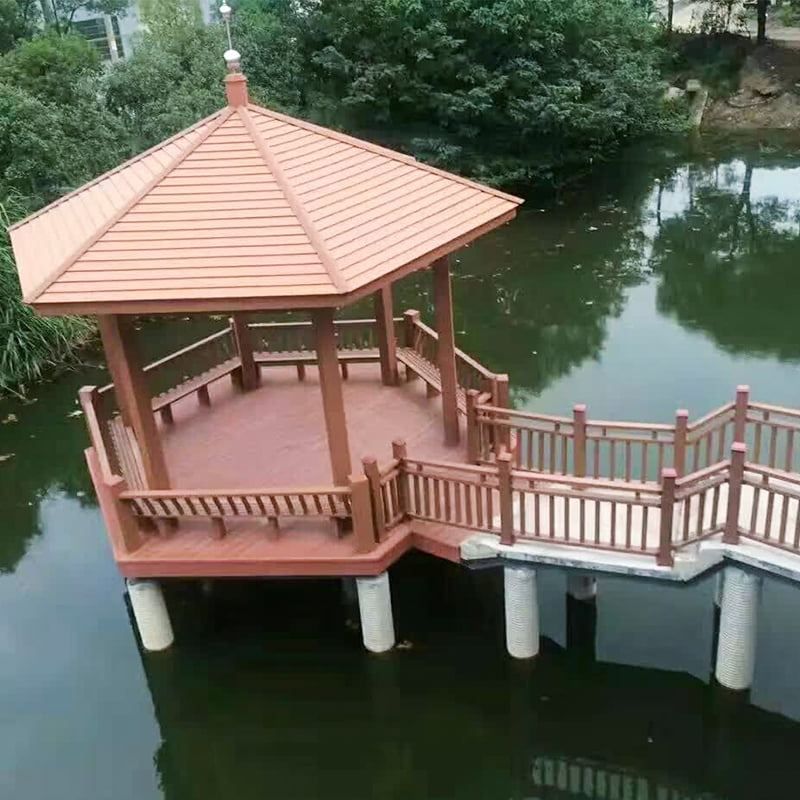Provide you with the latest enterprise and industry news.
In modern garden design and outdoor leisure space, pavilions are a common and popular structure that provides people with a place to get close to nature and relax. With the advancement of material technology, Wood Plastic Composite (WPC) has gradually become the preferred material for outdoor pavilions. So why can WPC pavilions stand out from many materials and become an ideal choice for outdoor spaces?
WPC is a composite material synthesized by wood fiber and plastic through high temperature and high pressure process, which combines the natural appearance of wood and the durability of plastic. Due to its superior performance, WPC materials are widely used in the construction of outdoor floors, fences, wall panels and pavilions.
Compared with traditional wood, WPC materials have excellent water resistance and weather resistance, and can be exposed to humid and rainy environments for a long time without rotting, deformation or cracking. This makes WPC pavilions extremely durable in outdoor environments and can maintain the integrity of their structure and appearance for a long time.

WPC materials do not need to be regularly oiled or painted like wood. Their surface is smooth and not easy to accumulate dust. They only need to be cleaned occasionally to keep them clean. Therefore, WPC pavilions save users a lot of maintenance costs and energy, and are very suitable for consumers who want to have a low-maintenance, long-lasting and beautiful outdoor leisure space.
Due to its excellent material properties, WPC pavilions have many advantages that traditional wooden pavilions do not have. Here are some of the main advantages of WPC pavilions:
During the manufacturing process of WPC materials, most of them use recycled plastics and wood fibers, which reduces the consumption of natural resources. At the same time, WPC materials themselves can be recycled and will not cause secondary pollution to the environment. Therefore, choosing WPC pavilions not only helps environmental protection, but also responds to the trend of sustainable development.
WPC materials can imitate a variety of wood textures and colors to meet the needs of different design styles. From traditional natural style to modern minimalist style, WPC pavilions can be easily integrated into the design of various gardens and outdoor spaces. In addition, WPC materials have good plasticity and can be customized in different shapes and sizes according to specific needs, providing greater design freedom.
The surface of WPC materials is smooth, so there is no need to worry about the burr problem that may occur in traditional wood, and it is safer to use. In addition, WPC materials are not easy to absorb heat, and will not be overheated in high temperature environments in summer, so users can enjoy outdoor time in the pavilion with confidence.
With the increasing demand for environmentally friendly materials and low-maintenance building materials, WPC pavilions have gradually occupied an important position in the market. Especially in the construction of urban landscape design, residential gardens and public leisure areas, WPC pavilions are increasingly favored by designers and consumers.
As people's requirements for the quality of outdoor life increase, the market demand for WPC pavilions has increased significantly. According to market research, the global market size of WPC materials is growing steadily, especially in the European, American and Asian markets, where WPC pavilions are popular for their durability and environmental protection.
With its excellent material properties, diverse design possibilities and environmental protection and low maintenance advantages, WPC pavilions have become an ideal choice in modern outdoor leisure spaces. With the continuous growth of market demand, WPC pavilions will continue to play an important role in future garden design and outdoor construction, bringing people a more comfortable and environmentally friendly outdoor experience.



 English
English Español
Español














